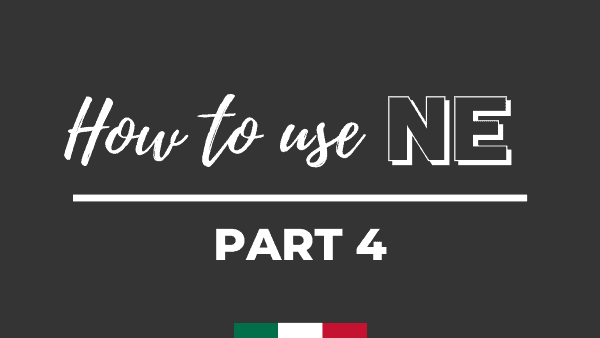How can we translate UNTIL NOW in italian?
Arwa asks: “How do I say UNTIL NOW in Italian? Also find out to say SO FAR!”
This one's pretty simple!
There are mainly three ways to say “UNTIL NOW” in Italian. Well, four, but one is just too long!
- FINORA
- FINO ADESSO
- FINO AD ORA
and the longer FINO AD ADESSO.
Download the PDF
No email required
▷ SOME EXAMPLES
I had never eaten ribollita. Until now!
NON AVEVO MAI MANGIATO LA RIBOLLITA. FINORA!
NON AVEVO MAI MANGIATO LA RIBOLLITA. FINO ADESSO!
NON AVEVO MAI MANGIATO LA RIBOLLITA. FINO AD ORA!
I had never considered that perspective, until now.
NON AVEVO CONSIDERATO QUELLA PROSPETTIVA FINO AD ORA
NON AVEVO CONSIDERATO QUELLA PROSPETTIVA FINO ADESSO
NON AVEVO CONSIDERATO QUELLA PROSPETTIVA FINORA
Of course we could place the “FINORA” in another spot. Watch this:
FINORA, NON AVEVO CONSIDERATO QUELLA PROSPETTIVA
FINO ADESSO NON AVEVO MAI MANGIATO LA RIBOLLITA
Learn Italian to Fluency
- The program you've been dreaming of is here
- Better than having a private tutor
- In-Depth Italian lessons for complete clarity
- Extensive pratice opportunities
- Access to our community - you are never alone!
- A true learning experience to Italian Fluency
What tense do we use with “FINORA“?
In most cases, we will use a past tense, when using expressions like FINORA. That's because what they simply is that something WAS a certain way, until it changed, just now.
The past tense we use the most with FINORA is the Trapassato Prossimo. The past in the past (equivalent to the English Pluperfect).
Manu, I don't know what the Pluperfect is…!
I'm glad you asked. In Italian we use the Trapassato Prossimo to talk about something in the past, that happened before something else… which also happened in the past, in relation to now.
It works (or it should work) the same in English. Check this out.
When I went to Italy two years ago, I had already learned Italian.
QUANDO SONO ANDATO IN ITALIA DUE ANNI FA, AVEVO GIÀ IMPARATO L'ITALIANO.
This means that NOW I am talking about the time I WENT to Italy (2 years ago). BACK THEN (2 years ago) my learning of the Italian language HAD ALREADY HAPPENED.
To construct the TRAPASSATO PROSSIMO in Italian all you need to know is the IMPERFETTO of the AUXILIARY VERBS ESSERE (to be) and AVERE (to have) and the PAST PARTICIPLE of the verb you want to use.
This is not the lesson where we talk about which auxiliary verb you need (you need to first be familiar with the “PASSATO PROSSIMO”), but let's say that you know that you should be using AVERE for a verb like IMPARARE (to learn).
You would conjugate AVERE in the IMPERFETTO (io avevo, tu avevi, lei aveva, noi avevamo, voi avevate, loro avevano) and then add the PAST PARTICIPLE of IMPARARE, which is IMPARATO.
And there you have it.
IO AVEVO IMPARATO
I had learned
TU AVEVI IMPARATO
You had learned
LEI / LUI AVEVA IMPARATO
She / he had learned
NOI AVEVAMO IMPARATO
We had learned
LORO AVEVANO IMPARATO
Hey had learned
Now back to UNTIL NOW!
Well, not quite. We are done with UNTIL NOW. But let's look at something similiar.
In English you could say:
I’m happy with my new job so far.
OR
I was happy with my new job until now
Two very different sentences, with different meanings.
In the first one, you were happy before and you still are. And you are uncertain about the future.
In the second sentence, you were happy before, but you no longer are. And probably will not be in the future.
In the first case, you use the PRESENT TENSE and the expression SO FAR.
In the second case, you use the PAST TENSE and the expression UNTIL NOW.
This is how it works in Italian:
I’m happy with my new job so far.
PER ORA SONO CONTENTO DEL MIO NUOVO LAVORO
I was happy with my new job until now
FINORA SONO STATO CONTENTO DEL MIO NUOVO LAVORO
(sono stato = I was)
OR
SONO STATO CONTENTO DEL MIO NUOVO LAVORO, FINORA
(sono stato = I was)
OR
ERO CONTENTO DEL MIO NUOVO LAVORO, FINORA
(ero stato = I had been)
Download the PDF
No email required



